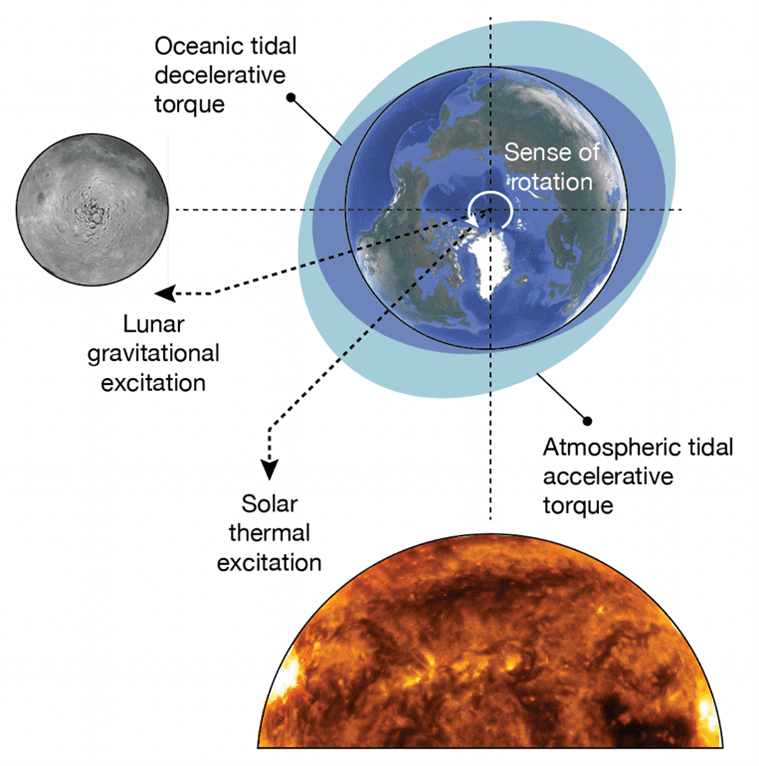The Earth’s days are slowly getting longer, thanks mostly to the Moon. However, it seems this is a much less even process than has been imagined, with the lengthening having stalled at least once. For a long period starting around two billion years ago, it may have stopped entirely, something that may have been driven by changes to Earth’s atmosphere.
If you’re one of those people with a natural tendency to stay up a little later each night, as if adapted to a 25-hour day, you can think of yourself as a Martian (and might do well operating rovers for NASA). Alternatively, you can just consider yourself ahead of your time, because one day the Earth’s spin will slow down enough that the day will be an hour longer. However, efforts to predict when that will be have just hit a major disruption.
Interactions between the Earth and the Moon have slowly pushed our satellite away, in the process slowing the Earth’s spin. While the basic physics of this can be taught in high school, the ability to capture the speed of the process is very difficult. So hard, in fact, a new paper argues we’ve been getting it wrong.
“Over time, the Moon has stolen Earth’s rotational energy to boost it into a higher orbit farther from Earth,” said study author Professor Ross Mitchell of the Chinese Academy of Sciences in a statement sent to IFLScience. Slower rotation inevitably extends the day.
“Most models of Earth’s rotation predict that day length was consistently shorter and shorter going back in time,” added study author Dr Uwe Kirscher of Curtin University. However, Mitchell and Kirscher have concluded instead that after the Moon’s formation, Earth’s days initially grew longer but then stalled at about 19 hours long before the lengthening resumed.
Intriguingly, the period of little or no change ran from two to one billion years ago. This coincides with the era geologists call the “boring billion” because so little happened in the period prior to the sudden explosion of multicellular life. The pair don’t think this is a coincidence.
The stalling occurred because the Moon is not the only celestial object affecting our day. The heat from the Sun produces tides in the atmosphere, which speed rotation up. Currently, the solar tides are much weaker than the lunar ones and merely moderate the Moon’s effect slightly.

While the Moon is making tides in the ocean, the Sun’s heat makes them in the atmosphere, and these have opposite effects on the Earth’s rotation
Image Credit: Nature Geoscience/ Mitchell and Kirscher
However, when the Moon was closer; “The frictional coupling between Earth and the Moon was weaker due to the faster rotation of Earth,” Mitchell told IFLScience. The tidal frequencies were not resonant with the Earth on a global scale, hindering energy transfer.
Mitchell and Kirscher wondered if the Moon’s force might have been so small for a while that the Sun completely canceled it out, and their paper confirms this. Even with the Moon’s relative weakness, this would have required a more powerful solar influence, which the authors attribute to the composition of the atmosphere at the time, when oxygen levels were low but ozone was high.
“The solar tides are excited by the absorption of sunlight by water vapor and ozone,” Mitchell told IFLScience. Only during the period between the Great Oxidation Event and the rise in O2 that stimulated the birth of animals – making geology interesting again in the process – was this possible.
The paper explains the reason the Moon is able to steal rotational energy is that the day is much shorter than the month it takes the Moon to orbit the Earth. “Earth’s oceanic tidal bulge is pushed ahead of the Moon. This offset exerts a torque on the Moon,” the authors write in the paper. On Mars, by contrast, Phobos – with an orbit shorter than the Martian day – is being pulled closer to the planet by the tidal bulge, although the absence of water bodies impedes this process.
Measurements of past day lengths have traditionally relied on fine sedimentary layers in ancient tidal mudflats. These can be so detailed it is possible to count the number of days between monthly tidal cycles.
Few sites are clear enough to use in this way, and even some of these are disputed, so we only have snapshots of how long the day was at specific points.
Mitchell and Kirscher used Milankovitch cycles in the Earth’s orbit instead. “Two Milankovitch cycles, precession and obliquity, are related to the wobble and tilt of Earth’s rotation axis in space. The faster rotation of early Earth can therefore be detected in shorter precession and obliquity cycles in the past,” Kirscher said.
The study is published in the journal Nature Geoscience.
Source Link: Earth's Days Stopped Getting Longer For A Billion Year Period